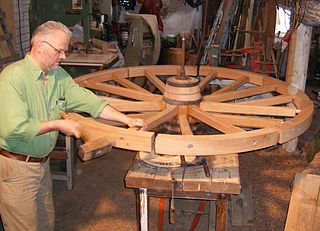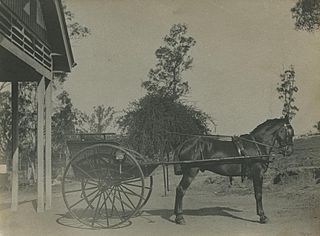
A cart or dray is a vehicle designed for transport, using two wheels and normally pulled by draught animals such as horses, donkeys, mules and oxen, or even smaller animals such as goats or large dogs.

A stagecoach is a four-wheeled public transport coach used to carry paying passengers and light packages on journeys long enough to need a change of horses. It is strongly sprung and generally drawn by four horses although some versions are drawn by six horses.

A carriage is a private four-wheeled vehicle for people and is most commonly horse-drawn. Second-hand private carriages were common public transport, the equivalent of modern cars used as taxis. Carriage suspensions are by leather strapping or, on those made in recent centuries, steel springs. Two-wheeled carriages are informal and usually owner-driven.

A wagon or waggon is a heavy four-wheeled vehicle pulled by draught animals or on occasion by humans, used for transporting goods, commodities, agricultural materials, supplies and sometimes people.

The hansom cab is a kind of horse-drawn carriage designed and patented in 1834 by Joseph Hansom, an architect from York. The vehicle was developed and tested by Hansom in Hinckley, Leicestershire, England. Originally called the Hansom safety cab, it was designed to combine speed with safety, with a low centre of gravity for safe cornering. Hansom's original design was modified by John Chapman and several others to improve its practicability, but retained Hansom's name.

A wheelwright is a craftsman who builds or repairs wooden wheels. The word is the combination of "wheel" and the word "wright" as in shipwright and arkwright. This occupational name became the English surname Wright. It also appears in surnames like Cartwright and Wainwright. It corresponds with skilful metal workers being called Smith.

A sulky is a lightweight cart used for harness racing. It has two wheels and a small seat for only a single driver. The modern racing sulky has shafts that extend in a continuous bow behind the driver's seat, with wire-spoked "bike" wheels and inflated tyres. A sulky is frequently called a "bike". Historically, sulkies were built for trotting matches and made from wood with very tall wheels and almost no body, just a simple frame supporting a single seat. Such vehicles were called "sulkies" because they were "said to have been chosen by unsociable people fond of their own company or fits of sulking".

John Lockwood Kipling was an English art teacher, illustrator and museum curator who spent most of his career in India. He was the father of the author Rudyard Kipling.

An oxOKS, also known as a bullock, is a bovine, trained and used as a draft animal. Oxen are commonly castrated adult male cattle; castration inhibits testosterone and aggression, which makes the males docile and safer to work with. Cows or bulls may also be used in some areas.

A bullock cart or ox cart is a two-wheeled or four-wheeled vehicle pulled by oxen. It is a means of transportation used since ancient times in many parts of the world. They are still used today where modern vehicles are too expensive or the infrastructure favor them.

A horse-drawn vehicle is a piece of equipment pulled by one or more horses. These vehicles typically have two or four wheels and were used to carry passengers or a load. They were once common worldwide, but they have mostly been replaced by automobiles and other forms of self-propelled transport but are still in use today.

The artillery wheel was a nineteenth-century and early-twentieth-century style of wagon, gun carriage, and automobile wheel. Rather than having its spokes mortised into a wooden nave (hub), it has them fitted together in a keystone fashion with miter joints, bolted into a two-piece metal nave. Its tyre is shrunk onto the rim in the usual way, but it may also be bolted on for security.

A dogcart is a two-wheeled horse-drawn vehicle pulled by a single horse in shafts, or driven tandem. With seating for four, it was designed for sporting shooters and their gun dogs, with a louvred box under the driver's seat to contain dogs. It was developed in the early 1800s to afford more seating than the gig, which seats only two. Seating is two back-to-back crosswise seats, an arrangement called dos-à-dos from French. There is a hinged tailboard which lowers slightly and, supported by chains, acts as a footrest for the rear-facing passengers. Some dogcarts had a mechanism to slide the entire body forward or rearward along the shafts to help balance the weight for the horse.

An ox-wagon or bullock wagon is a four-wheeled vehicle pulled by oxen. It was a traditional form of transport, especially in Southern Africa but also in New Zealand and Australia. Ox-wagons were also used in the United States. The first recorded use of an ox-wagon was around 1670, but they continue to be used in some areas up to modern times.

A tonga or tanga is a two-wheeled carriage drawn by a single horse. It is used for transportation in the Indian subcontinent. There is a canopy over the body, one seat faces forward for the driver and one passenger, and one seat faces the rear for a second passenger. Some space is available for baggage below the carriage, between the wheels. This space is often used to carry hay for the horses.

A Vardo is a four-wheeled horse-drawn vehicle used by British Romanichal Travellers as their home. It is pulled by a single horse in shafts, sometimes with a second horse hitched on its right side outside the shafts to help pull heavier loads or assist in pulling up a hill. The vehicle is typically highly decorated, intricately carved, brightly painted, and even gilded. The Romanichal Traveller tradition of the vardo is seen as a high cultural point of both artistic design and a masterpiece of woodcrafter's art.

Driving, when applied to horses, ponies, mules, or donkeys, is a broad term for hitching equines to a wagon, carriage, cart, sleigh, or other horse-drawn vehicle by means of a harness and working them in this way. It encompasses a wide range of activities from pleasure driving, to harness racing, to farm work, horse shows, and even international combined driving.

A trap, pony trap or horse trap is a light, often sporty, two-wheeled or sometimes four-wheeled horse- or pony-drawn carriage, usually accommodating two to four persons in various seating arrangements, such as face-to-face or back-to-back. In the eighteenth century, the first carriage to be called a trap was a gig with a hinged trap door, under which was a place to carry a dog. In late nineteenth century USA, four-wheeled dog carts with convertible seats also started to become known as traps.

Rickshaw originally denoted a pulled rickshaw, which is a two- or three-wheeled cart generally pulled by one person carrying one passenger. The first known use of the term was in 1879. Over time, cycle rickshaws, auto rickshaws, and electric rickshaws were invented, and have replaced the original pulled rickshaws, with a few exceptions for their use in tourism.

A hobby horse is a child's toy horse. Children played at riding a wooden hobby horse made of a straight stick with a small horse's head, and perhaps reins, attached to one end. The bottom end of the stick sometimes had a small wheel or wheels attached. This toy was also sometimes known as a cock horse or stick horse.





















